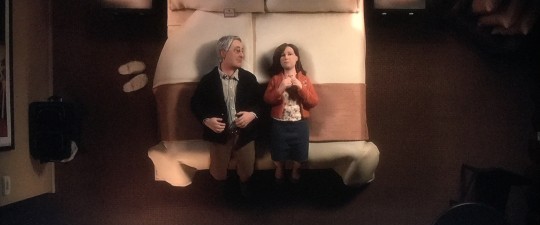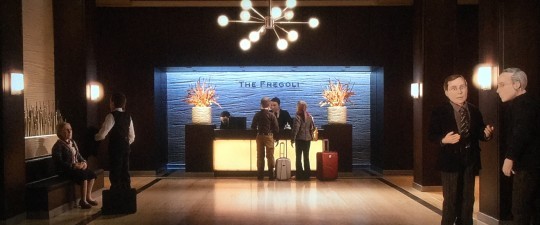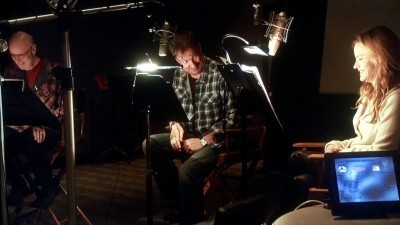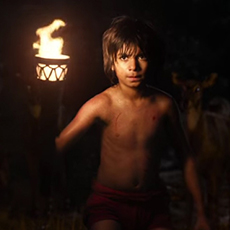Paramount/Starburns Industries (December 30 2015), Paramount Home Entertainment (June 7 2016), Blu-ray plus DVD, 90 mins plus supplements, 1080p high-definition widescreen 2.35:1, DTS-HD Master Audio 5.1, Rated R (for sexual content, nudity and language), Retail: $39.99
Storyboard:
In Cincinnati to deliver a speech, a motivational speaker, at a point in his life that is anything but inspirational, finds himself on a personal odyssey and discovers solace with one of his attendees. Or does he…?

The Sweatbox Review:
Being an art-house release that never made it to my stick of the woods, I wasn’t quite sure what to expect from the Academy Award-nominated Anomalisa, the latest diversion into animation by a live-action director, in this case the mind of Charlie Kaufman, that was widely, on one hand, praised as a masterpiece but, on the other, had Animated Views’ own theatrical critic ultimately forgoing the chance to publish his review because of how frustrating he found the experience and didn’t have a good word to say about it! So going in I was faced without knowing too much about the film itself, and with two diametrically opposing standpoints on the result.
I did know that Anomalisa was based on a “sound play” by Kaufman, written and performed in 2005 (a date the film keeps for its setting), in which the cast (also retained for the film) read the script on stage, accompanied by Foley sound effects and a live music score, by Carter Burwell, also featured again here. I had also, along with most, enjoyed Kaufman’s screenplays for his breakthrough Being John Malkovich and follow-up Eternal Sunshine Of The Spotless Mind, although more recent work has been a little hit and miss, and Anomalisa itself had to turn to Kickstarter to raise funding.

Co-directed with stop-motion animator Duke Johnson, it’s clear from the outset that Anomalisa won’t be for everybody: it’s an R-rated adult animated feature for starters, featuring very adult situations, so it’s probably best to keep the kids out of the room. It also took me a moment to adjust to seeing the joins in the characters’ faces: usually these lines – between the various eyes and mouth sections of the interchangeable molded parts – are blurred out by computer magic, but are instead retained here not just, I imagine, for budgetary concerns, but to call attention to themselves when they play a typically Kaufman part later in proceedings (he even wrote the play under the pen name of Fregoli, a syndrome that has a direct correspondence to the events that transpire here).
The appearance of these facial lines almost define the visual look of the film, with a number of juxtaposing elements that counteract each other and, I suspect, are totally intended. For in every exquisite detail of the characters themselves, we have the unfinished, rough quality of those joins on show (it’s not actually that distracting, being more as if each character is wearing glasses). All the wonderful, hand-crafted props and created sets (especially the run-off-the-mill hotel room, perfectly realised in its boring, cookie-cutter fashion) recall the extraordinary work in Team America: World Police, although the costuming goes back earlier to that film’s original Thunderbirds inspiration, where the clothes don’t quite fit properly and come off a little bulky. I’m either reading too much into things here, or they all do indeed mean something.

There’s also an innocence or even a slight naïveté to the resulting animation itself, which reminded me a little of Fantastic Mr Fox in its approach, with everything moving slightly slowly, from the way the characters walk to how our protagonist, Michael Stone, tosses a credit card onto a table top. From the opening moments, there’s a dreamlike quality at play that’s all quite mesmerising in the “nothingness” of it all, filled with small talk and, essentially, “real life”. The vocal performances help here, too, with David Thewlis (previously of stop-motion voice work in James And The Giant Peach and Remus Lupin in the Harry Potter films) bringing a true fish-out-of-water quality to Stone with his northern England accent sticking out in deep American Cincinnati, and Tom Noonan (an actor who has done so much better work than his two biggest successes, RoboCop 2 and The Last Action Hero, suggest since his breakout in the original Hannibal Lecktor thriller Manhunter in the 80s) basically voicing everyone else here.
Hearing the same, intentionally monotonous, voice coming from all the other characters also takes a moment to get used to at first, especially as most of them are female, but this is part of the ploy to get us to share Stone’s feelings of being out of place, slowly closing himself down as a way to cope and shutting the outside world out so that all the different voices and faces essentially become one and the same thing. Even more so, to Noonan’s credit, he quickly manages to somehow make us forget this as a potential gimmick, and captures the essence of each role – from Stone’s young kid on the phone and a bemused waitress to a forcefully jovial bellhop in just a dead end job as Stone’s – authentically and creatively.

And then, before I knew it, the first half hour had whizzed by and I found I had been mesmerised by an amusing incident on Stone’s plane as it landed, the banter with a surly taxi driver (in a beautifully animated cab ride) and his slightly surreal arrival at the wittily pronounced Fregoli hotel, all delivered in a knowing, droll way by the performers who pull out every nuance from the wry and very dry script and its occasional observations of the banal and inane. (If there is a major criticism, it’s against the unrelenting use of the f-word, liberally thrown into every line at one point. I’m certainly not against its use when needed, but it’s profuse here, even at times when it didn’t seem to fit, and overbearingly so that it can lose its impact.) An ill-advised and failed attempt at bringing a spark back to a failed relationship sets Stone – a guy with obvious home life strife – off on his downward spiral, his life of mundane drabness and redundant customer service expert/author job unraveling as his personal crisis intensifies.
Which is why we are also struck when we hear a genuine female voice (Jennifer Jason Leigh, having a great year along with The Hateful Eight, although that’s a very long and drawn-out film devoid of Tarantino’s usually sparky dialogue) that could perhaps turn out to be Stone’s savior. It’s around the half-way mark when he meets this Lisa of the title (which does have a fun, and smart, explanation), where Stone really is searching for some – any – kind of excitement in his life, and I confess I did start wondering if all the “realness” was getting a bit heavy handed, but the slow nature of the film and its lack of fast cutting – shots and takes are long and leisurely – is really preparing us for the moment when Stone and Lisa consummate their meeting, where the fairly abstract witnessing of puppet sex could be laughable or, worse, bring back memories of Team America‘s outrageous scene. That it doesn’t is testament to how dimensional and layered the animation, writing and performances are: it’s actually funny, sweet and poignant.

And then things get really Kaufmanesque… Has the world gone all The Adjustment Bureau, or is it all in Stone’s mind? Slowly things continue to fall apart, as he tries to balance his life as was, or is, with what it could have been, or could still be, all as the pressure of his upcoming conference speech continues to build, until he comes to the conclusion that, although new experiences and relationships can feel different and exciting at first, at the end of the day the new can quickly become the same-old same-old. And perhaps that’s just what Michael Stone really needs, his ultimately returning home a sign that he, subconsciously at least, prefers the comfortable and familiar, even if he may continue to wistfully dream of what might be…
Kaufman’s concepts have often been stronger than his endings, and I am certainly no fan of oblique finishes, especially in “real world” dramas, but where the likes of August: Osage County and this year’s bafflingly lauded insomnia cure 45 Years failed to make any comment on their conclusions, here Kaufman really nails it and, just when I was about to worry that the film would cut to black without any meaning, that tiny final scene makes its point. Sure, like those films, Anomalisa is ultimately about “nothing”, and about not much happening to a guy in a room other than having a one night stand (with a complicated woman who has her own inhibitions) before returning home, something I am sure occurs more times than not when staff are “away on business”. But, for Michael Stone, what he is going through and endures is massive, and it is conveyed well.

There are no rows, no histrionics…just a man coming to terms with his own life and the choices he has made, or could yet make. It opens up a conversation about how we leave him and how he might continue, rather than putting a safe lid on things or, heaven forbid, doing the conventional and cutting to black, leaving the audience with a real “WTF was that!” moment of the sort that had Mariah Carey fans reeling at the end of the infamously bizarre Glitter. But there is an amount of closure here too, although I wonder if it might help to appreciate the film more having experienced some of the situations Stone is going through.
Being alone in a bland hotel room in an unfamiliar location can be quite disconcerting, and the damage to people who live these kinds of lives on the road all the time and have no real roots of their own has been explored in other films, such as the George Clooney starrer Up In The Air. There’s ultimately no reason why Anomalisa couldn’t have been made as a live-action film too – I did catch glimpses of a Robert De Niro or, ironically, Clooney type in Stone’s face – but in a sense it’s the very fact that this is animated which gives it a certain reason for being. Anomalisa is the kind of film where you’ll either get it or you don’t. I’d like to think that I did.
Is This Thing Loaded?
Although a commentary track that I might have expected is a no-show, a nice surprise is a trio of behind the scenes featurettes that highlight the making of the production. The extensive None Of Them Are You: Crafting Anomalisa is the disc’s centerpiece, half hour documentary, speaking with all the main players and traveling Anomalisa‘s journey from the page, through the original stage production (shown briefly in photographs), to the pre-viz, recording process, development and sometimes incident-prone animation of the film. This isn’t just your usual, run-of-the-mill making-of, with an intricately fascinating depth of discussion not seen in pieces of this kind for a long while. If you like the movie itself, you’ll get a lot out of this, the only downside being that the interview sound, including more f-bomb instances, is occasionally a little distorted for some reason.

Intimacy In Miniature takes a similar look at the film’s much-talked about moment, spending its near ten-minute run time to examine the initial approach to the scene (for which, yes, the filmmakers were well aware of the pitfalls of reminding audiences of, or being compared to, Team America) and the incredible amount of detail inherent in achieving what could be seen as something very comical in a real, believable way. Finally, the almost six-minute The Sound Of Unease takes a brief look, obviously from its title, at the film’s soundtrack and how the filmmakers wanted to capture the feel of real world sounds instead of the kind of overly perfect Foley track that most animated features rely on, providing a further layer of authenticity in portraying the puppets as real characters in situations we can identify with. A trailer might have been a nice final touch, but this is a nice, comprehensive collection of supplements.
Case Study:
Another surprise is the addition of a slipcover to the packaging, which gives this unique film a touch of class. A DVD of the feature is included, as is a code for a Digital HD copy.
Ink And Paint:
Shooting in the wide 2.35:1 aspect ratio helps Anomalisa to look much more cinematic and break free of any perceived stage presentation or low-budget confines and the results are very pleasing. There’s an immediacy to the image that puts us right in Michael’s room and lets us explore the all-too real aspects of his nice enough but basic hotel location, while the soft lighting further evokes the intricate live-action feel. As noted above, the faces are extraordinary in their detail even though their molded construction is apparent, something that plays into Stone’s fears later in one of the film’s most surreal moments.

Scratch Tracks:
Essentially having the actors read the script from the original play means they’re all familiar with the characters enough for the recording process to take precedence, and everything here is clean and perfectly delivered. The creative use of 5.1 sound is involving, too, especially the background murmurings of tens of Noonans chattering away on the plane or in a restaurant, leading to a cacophony of hum that becomes as indecipherable to us as it is intended to be for Stone. Ironically for one of the original project’s instigators, Carter Burwell’s score doesn’t register as much as it could, but this is no doubt a creative decision that sits it in the mix as soft as the visual side’s lighting approach.
Final Cut:
So Anomalisa won’t be for everyone, and with its huge dropping of f-bombs and full frontal nudity it’s certainly not for the kids. But adults of a certain age and disposition should find it an interesting and possibly compelling rumination on mid-life and the crossroads many may face. With its exquisite detailing and careful animation where, at one point, a single glance from a character is worth a paragraph of words, it can come across as being quite real, without any hint of caricature other than in some of the personalities and surroundings that Michael and his Lisa find themselves in. Paramount’s grade-one package adds a nice selection of extras to a first-rate presentation, and one can easily see the various reasons as to why the film was Oscar-nominated. Anomalisa is recommended for when in the right frame of mind, although probably not for when one is stuck alone in a hotel room late at night.
 |  |









